Last updated on September 3rd, 2013
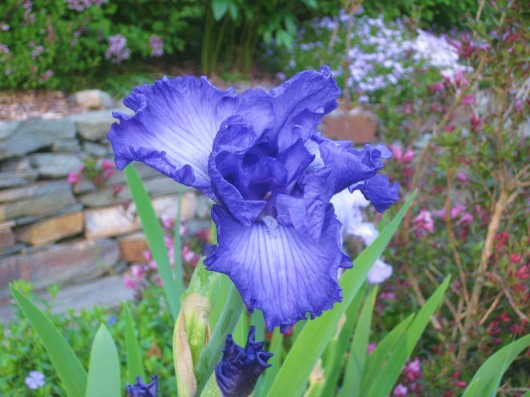 I’D LIKE TO TELL YOU that September is a restful month. But alas, this is the time to divide and reset perennials, order and plant bulbs, set up a window garden, and prepare the vacationing houseplants for their return to indoor life. Feeling energetic? Good. You’ll reap great rewards later on if you accomplish the following now:
I’D LIKE TO TELL YOU that September is a restful month. But alas, this is the time to divide and reset perennials, order and plant bulbs, set up a window garden, and prepare the vacationing houseplants for their return to indoor life. Feeling energetic? Good. You’ll reap great rewards later on if you accomplish the following now:
Bulbs. Order early, and with purpose. Print out a copy of your order form, and note each bulb’s height, color and location for planting. This way you won’t get caught — like I was, one year — standing in the cold with a bag of hyacinths and not the slightest clue where to plant them. (I always order extra tulips, daffodils, Dutch hyacinths and muscari for advance bloom in the house.) Here are my favorite bulbs for planting indoors and out.
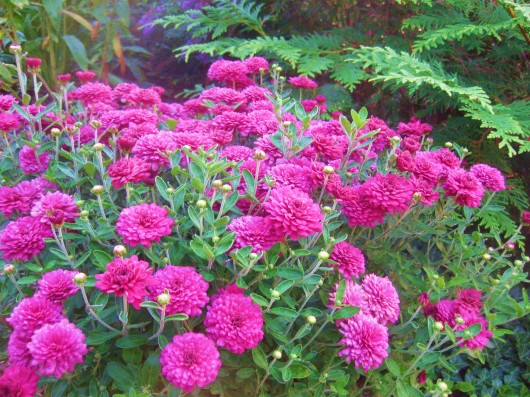 Chrysanthemums. If you don’t already have these in your garden, why not splurge on a few now? They do wonders for the September-to-frost border. Chrysanthemum ‘Helen’ (above), blooms year after year in my Serpentine Garden, just when other perennials are beginning to wane. If you don’t wish to plant the mums, just tuck pots beneath trees and between other plants for temporary decoration.
Chrysanthemums. If you don’t already have these in your garden, why not splurge on a few now? They do wonders for the September-to-frost border. Chrysanthemum ‘Helen’ (above), blooms year after year in my Serpentine Garden, just when other perennials are beginning to wane. If you don’t wish to plant the mums, just tuck pots beneath trees and between other plants for temporary decoration.
Iris. Divide and reset crowded clumps, but remember to keep rhizome tops exposed.
Lilies. After flowers fade, cut stems back to the ground. Don’t clip foliage until turns yellow and becomes loose.
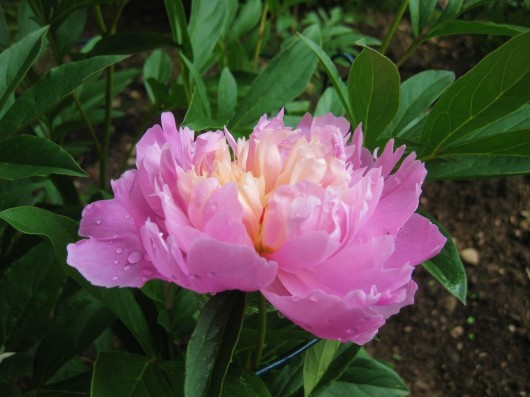 Peony. Divide and transplant any poor-blooming old plants or set out new ones this month. They need sun, good drainage and only two to three inches of soil over the crowns.
Peony. Divide and transplant any poor-blooming old plants or set out new ones this month. They need sun, good drainage and only two to three inches of soil over the crowns.
Roses. Keep deadheading, but stop feeding. Roses need to prepare themselves for winter dormancy — not new growth.
Vegetables
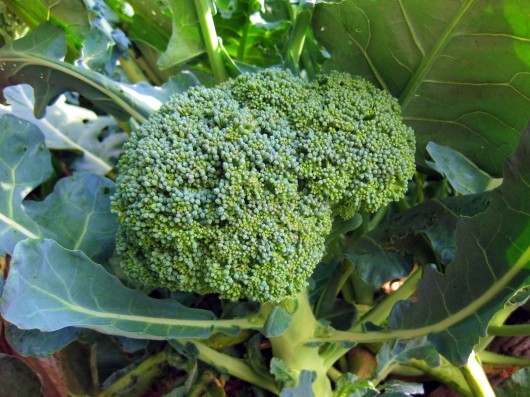 Broccoli. If you’d like to freeze your autumn harvest, follow these directions.
Broccoli. If you’d like to freeze your autumn harvest, follow these directions.
Cabbage. Are slugs eating the leaves? Stop this destruction by spreading iron phosphate (sold as “Sluggo”) beneath the plants. By all accounts, iron phosphate is completely harmless to people and pets.
Carrots. Harvest what you need; leave the rest in the ground over winter. At the first spring thaw you’ll have some of the sweetest treats in the world. I speak from experience.
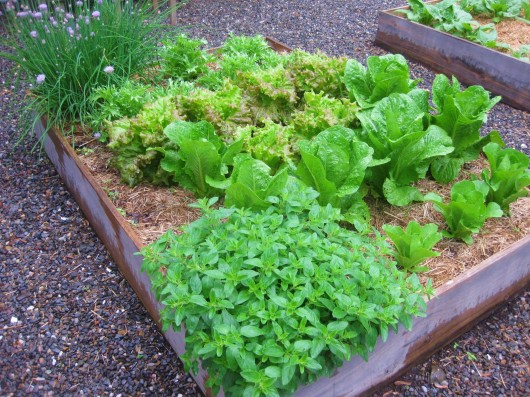 Salad Greens. Continue sowing until October 1. If a sudden hard frost is predicted, and you don’t have a proper row-cover, just throw a sheet over the crop.
Salad Greens. Continue sowing until October 1. If a sudden hard frost is predicted, and you don’t have a proper row-cover, just throw a sheet over the crop.
Onions. Harvest, cure and store according to these directions.
Potatoes. Although my potato vines have died back, I certainly won’t harvest the crop until really cool weather arrives (usually the end of October). This way my cellar will be cold, too, and thus better suited for potato-storage. Tubers only keep well in quarters which are dark, humid, and chilly (35-40 degrees F.). How I plant, grow, harvest, and store potatoes.
Tomatoes. To avoid the ravages of late blight, frost, or a severe storm, pick mature fruits while they are still green, and let them ripen in paper bags indoors. I find that a banana placed in each bag really speeds things up.
Herbs. Not sure how to freeze or store your garden’s bounty? I handle matters this way.
Indoor Gardening
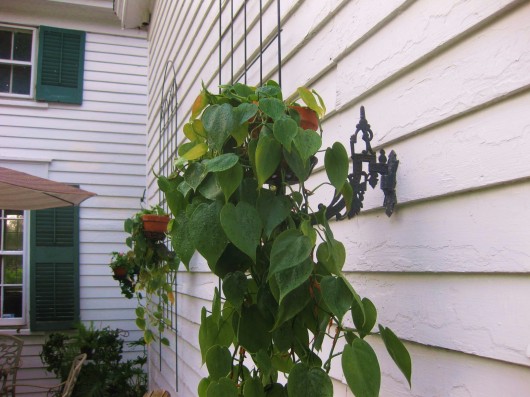 Vacationing Houseplants. Gradually condition these to indoor life before nights get cold. By Labor Day, I move mine to the porch where there is less light than in the open and they stay there for a week or two. Prior to their coming in, pots should be scrubbed, foliage cleansed with a firm blast of water, and both pot and plant sprayed with a good insecticide (I use House & Garden Raid). This way, plants will be in a clean condition and no pest epidemics will start. Indoors, keep windows open day and night to provide plenty of fresh air through the first weeks. Then there should be a minimum of leaf-drop and general discontent with the home environment.
Vacationing Houseplants. Gradually condition these to indoor life before nights get cold. By Labor Day, I move mine to the porch where there is less light than in the open and they stay there for a week or two. Prior to their coming in, pots should be scrubbed, foliage cleansed with a firm blast of water, and both pot and plant sprayed with a good insecticide (I use House & Garden Raid). This way, plants will be in a clean condition and no pest epidemics will start. Indoors, keep windows open day and night to provide plenty of fresh air through the first weeks. Then there should be a minimum of leaf-drop and general discontent with the home environment.
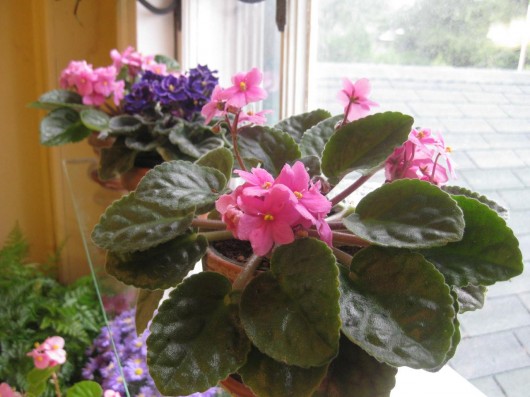 Design a Window Garden. Houseplants look their best, and are far easier to maintain, when you display them not just on a window sill, but in a real window garden. A window garden is an ordinary window that’s been outfitted with a broad sill and glass shelves. It takes neither money nor skill to create such decorative quarters for plants. Here’s proof.
Design a Window Garden. Houseplants look their best, and are far easier to maintain, when you display them not just on a window sill, but in a real window garden. A window garden is an ordinary window that’s been outfitted with a broad sill and glass shelves. It takes neither money nor skill to create such decorative quarters for plants. Here’s proof.
Petunias, Wax Begonias, Impatiens. Take cuttings now, and root them in pots of good soil. Brought indoors before frost, these tender annuals will provide cheerful bloom during the dark winter months.
Amaryllis. Induce dormancy the first week in September. To do this, lay the pot on its side and let the soil dry out. Remove the foliage after it turns yellow and becomes loose, and then bring the plant indoors to a dark and cool place. Give water not more than once every three weeks during the winter rest. Need more details? See my Amaryllis Growing Guide.
Is my monthly list of chores helpful to you in some small way? Perhaps you can let me know by leaving a comment.
Don’t miss anything at A Garden for the House…sign up for Kevin’s weekly newsletter.
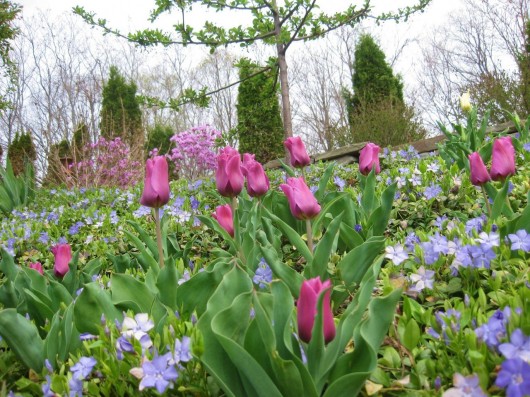

Lela says
This post is a “feast for the eyes” this early Saturday morning.
maria says
I just love your blog and your beautiful photos.
JoAnne Matzke says
You have the best blog of any! Thank you for all of the helpful information and fabulous recipes!
Jan Evancho says
Kevin, I always find something interesting in your newsletters. Thank you so much for sharing your wisdom with a group of strangers on the internet. It’s funny how, after reading your blog for a while, you feel like a friend! Keep up the good work!
Heather says
Thank you for the wonderful ideas and wisdom!
I tried to click the link for the “take cuttings now” and the link is not working. Is there somewhere else I can see this link?
Thank you!
Kevin Lee Jacobs says
Hi Heather – So sorry about that. The link is now fixed.
Jolene says
Regarding Peonies; can I cut them back if not dividing them? The plant looks tired now and not attractive in the garden at all.
Kevin Lee Jacobs says
Hi Jolene – You can cut back any dead or yellow peony leaves. Don’t touch the green leaves, or your plant won’t bloom well next year. Green leaves are necessary for photosynthesis (the conversion of sunlight into sugar).
Kristina says
Is now a good time to spread wood ash around peonies and lilacs, or is it too early? I used your newspaper under mulch trick for my peony bed, which has worked well so far. (Except for the chipmunks ripping through it to bury their stash.) Do I need to move the mulch and the paper to lay the ash down, or will it magically transfer through those barriers to the soil? Thanks for all your great feedback! Your hard work is much appreciated!
Kevin Lee Jacobs says
Hi Kristina – Ideally, you’ll want to apply wood ash around your peonies and lilacs in spring. This is when new growth begins, and the plants can actually use this nourishment. I do not remove newspaper when adding soil amendments. However, I usually push aside the mulch, apply the ash, and then replace the mulch. This way I avoid the unsightly appearance of ash on top of the garden bed.
Mary Ellen says
Thank you for telling me about the amaryllis! Mine have had a happy summer at the back of the garden, and I keep wondering when to bring them in. Thanks!
Kelly says
Hi Kevin,
I am thinking about making window shelves for my plants that are coming back inside this winter. I read your post on the window garden and it looks great. My only question is that I have curtains that I will need to close at night, so that will mean the plants are between the window and the curtain and I worry that it will be too cold for them ??
peg says
i can’t imagine how you accomplish all this AND share with us and cook/eat meals and sleep and go to the store and do laundry, and, and and…
you’re a garden/kitchen rock star! thanks kevin!
Lynda says
Hi,
thanks for all the info. I have never sprayed my indoor plants before bringing them in but this year the insects are so bad that I want to, is the Raid you mention safe for my pets?
Kevin Lee Jacobs says
Kelly – Given the choice, most houseplants prefer a cool or even cold window to a warm one. Why? Because the lower the temperature, the higher the humidity. Plants with fragrant flowers are particularly fond of the cold. In order to provide contentment for my freesia, jasmine, African gardenia and other plants, I close the curtain in my music room window on frigid winter nights.
Hi Peg – What a fun comment to read this morning! Thank you.
Hi Linda – The insecticide I use — Raid House & Garden — is certainly not pet-safe. But it is not a systemic product, and nor does it linger. I spray it outdoors, before bringing the houseplants in for the winter. With the exception of my spider-plant, which is beloved by Tiger the Cat, my pets don’t eat my houseplants. If your pets are nibblers, you should spray with a pet-safe insecticide.
Carolyn "Kelly" Crowley says
Great site! Wonderful source of information. Please — keep on “keeping on.”
pennifer says
It’s interesting to read about chores in a place with 4 seasons. Here on the San Francisco coast, the climate and seasons (such as they are) are completely different. I know that we have a dormant period late Dec-early Feb, but am not sure how to sync up the rest of it, since our climate operates on such a narrow range (most of the time the temp is in the mid 50s or mid 60s during the day and you get either sun or fog/mist, both with or without wind). I’ll see if I can convince my amaryllis to go dormant. Hasn’t been willing to kill off its leaves despite my attempts to convince it by means of drought.
Carol says
I love your great garden advice, your fantastic photos, and especially the list of what chores to do when. Even though I’ve been gardening for decades, there’s always something new to learn. I’m following our advice about my 3 amaryllis plants, which have been summering on the deck. I’ll let you know how (and if!) they bloom.
Thanks so much—it’s great to “meet” someone as nuts about gardening as I am!
badger gardener says
My Autumn Sedum looks as if someone dropped a soccer ball right in the middle of it. While that is not beyond the realm of possibility in my backyard, none of the stems are broken and overall it is healthy and flowering. I’m not sure if this is from some of the earlier season drought conditions, a neighborhood critter crawling through my garden, or is this a sign that it should be divided? If it needs dividing , is it best after Fall flowering or in Spring to ensure flowering for next year?
Kevin Lee Jacobs says
Hi badger gardener – The smaller growth in the center of your sedum indicates that division is necessary. Manage the job in early spring. Use a shovel to dig up the plant, and a sharp knife to cut it into sections.
badger gardener says
Thanks for the help.
I’m also going to take your advice above on carrots and leave the last few in the ground over Winter. I’ll definitely be looking forward to trying them come next Spring.
badger gardener says
Hi Kevin,
We dropped into the 30’s overnight for a few days/ 50 highs, so I brought in my tomatoes but left up my sweet million cherry (those don’t seem to ripen indoors). I wrapped it in some season-extending fabric. I just have to have another batch of those slow roasted cherry toms. Right now it looks like a ghostly bride ready for Halloween in my garden. My question is, now that we are moving to highs of mid-60’s-70, will it hurt to just leave it up instead of wrapping/unwrapping? Will it get too hot in there?
Kevin Lee Jacobs says
Hi badger gardener – I, personally, would remove the wrapping on mild days. But since light and air can permeate the fabric, it probably won’t hurt to leave it in place. How’s that for a yes/no-no/yes answer?
Pam Russell says
I just transitioned my outdoor plants to the garage for a week, hosed them off good, gave new potting mix, gave a few good tamps to drop off any clinging insects. My dressing room which has pretty good light was decluttered and voila ! it is now my winter garden sanctuary. I also bought a plant bulb to put in an extra tall lamp I had for extra measure. They all look so happy together, I pray they make it. That was a good tip on leaving the windows open day and night. (pending no bad storms of course) and when the weather gets so cold I can’t, turn off your heat register and keep the room cool (right ???)
This is an awesome site, keep the photos coming !
Kevin Lee Jacobs says
Hi Pam – Congratulations for finding an indoor oasis for your plants. You are right — keep them cool in winter, even if it means not heating your dressing room at all. If there’s anything plants hate, it’s a furnace!